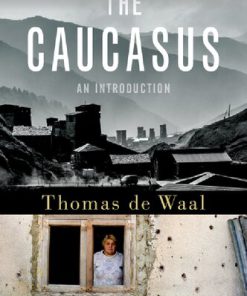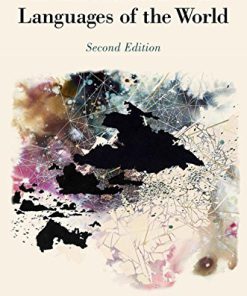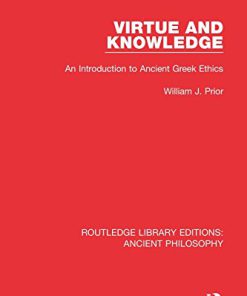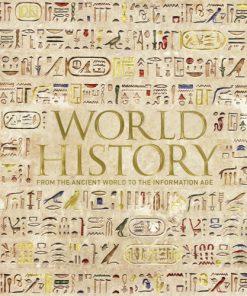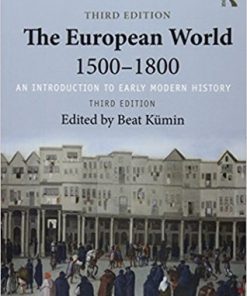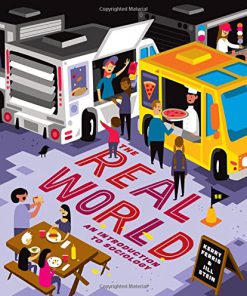An Introduction to the Ancient World 3rd edition by Lukas De Blois 1351245449 9781351245449
$50.00 Original price was: $50.00.$25.00Current price is: $25.00.
An Introduction to the Ancient World 3rd edition by Lukas De Blois – Ebook PDF Instant Download/DeliveryISBN: 1351245449, 9781351245449
Full download An Introduction to the Ancient World 3rd edition after payment.
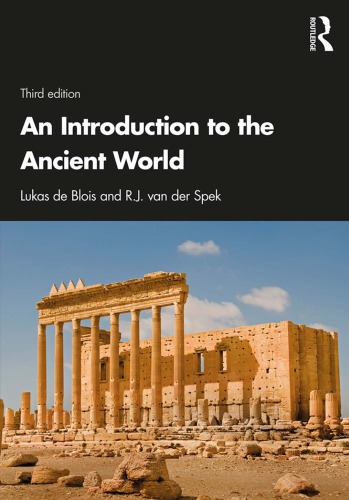
Product details:
ISBN-10 : 1351245449
ISBN-13 : 9781351245449
Author: Lukas De Blois
An Introduction to the Ancient World offers a thorough survey of the history of the ancient Near East, Greece and Rome. Covering the social, political, economic and cultural processes that have influenced later western and Near Eastern civilisations, this volume considers subjects such as the administrative structures, economies and religions of the ancient Near East, Athenian democracy, the development of classical Greek literature, the interaction of cultures in the Hellenistic world, the political and administrative system of the Roman Republic and empire, and the coming of Christianity, all within the broad outline of political history. This third edition is thoroughly updated and some chapters are completely rewritten to cover recent historical research. Changes include: more attention to economic structures and developments, and to the history of the later Roman Empire (third to sixth centuries AD); incorporation of the results of recent archaeological and historical research, and recently published studies of ancient literature; ‘boxes’ that support the main text, on topics including economic and political systems, religion and terminology; redrawn maps and new, higher-quality images; the inclusion of useful websites in the bibliography. An Introduction to the Ancient World provides an easily readable, user-friendly, integrated overview for students of ancient history, classics and archaeology. Lavishly illustrated, clearly and concisely written, and well organised, this fully updated and revised edition will remain a key resource for students beginning to investigate the civilisations of the ancient Mediterranean.
An Introduction to the Ancient World 3rd Table of contents:
Part I The ancient Near East
1 The origins of the civilisations of Egypt and Mesopotamia
2 The third millennium
The Early Bronze Age
Egypt, the Old Kingdom (c. 2600–c. 2150)
Mesopotamia, Sumer and Akkad
Epilogue
3 The second millennium
The Middle Bronze Age (c. 2000–c. 1600)
Egypt, the Middle Kingdom (c. 2000–c. 1800) and the Second Intermediate period (c. 1800–c. 1550)
Mesopotamia, the Old Assyrian and Old Babylonian periods
Northern Mesopotamia: the city of Assur and the kingdom of Shamshi-Adad I (c. 2000–c. 1760)
Southern Mesopotamia, the Old Babylonian empire (c. 1800–c. 1600)
The Late Bronze Age (c. 1600–c. 1200)
The ‘concert of powers’
Egypt, the New Kingdom (c. 1550–c. 1100)
Babylonia and Assyria
Mitanni
The Hittite empire
Crete and Mycenae
International relations
4 The first millennium
The Early Iron Age (c. 1200–c. 750 bc)
Disruption and recovery
Egypt, the Third Intermediate period (c. 1100–715 bc)
Syria and the Phoenicians
Israel
The West Asian empires (c. 750 bc–ad 651)
The Neo-Assyrian empire
The Neo-Babylonian empire
The Persian or Achaemenid empire
The Hellenistic kingdoms
The Parthian or Arsacid empire
The Neo-Persian or Sasanid empire
The Roman empire
The Arabs
5 Religion
Polytheism
Henotheism and monotheism
6 Economy and society
Agricultural economy, land tenure
A ‘redistribution economy’ and market economy
Trade and means of payment
Social organisation
7 Government
Kingship
The administrative machinery
The army
Part II The Greek world
8 The Early Iron Age (c. 1200–c. 750 bc): ‘The Dark Ages’
Disruption and recovery
9 The Archaic period (c. 750–c. 500 bc)
Introduction
Demographic and economic changes
The polis
Colonisation
Social changes
Military changes
Cultural changes
The alphabet
Literature
The visual arts
Architecture
Religion
Philosophy
Political changes
Tyranny
Sparta
Athens
10 The Classical period (c. 500–c. 330 bc)
The Persian Wars
Sparta and Athens after 479 bc
The Delian League (477–404 bc)
Athenian leaders in the fifth century
Athens’s state income
The Great Peloponnesian War (431–404 bc)
The years between 404 and 336 bc
The Second Athenian League (377–355)
Social and military changes
The rise of Macedonia
Philip II (359–336): the end of the Classical period in Greek history
The Athenian population in the fifth and fourth centuries bc
The metics
The slaves
Women in Athens and Sparta
Further development of the Athenian democracy
The Council of the Areopagus in 462/1
Pericles
The democracy and the fleet
Old and new politicians
The stability of the Athenian democracy
Criticism of the Athenian democracy
Athens as the centre of Greek culture in the Classical period
Attic drama
Philosophy
Historical writing
The Greeks in the western Mediterranean
The economy of the Greek city states
11 The Hellenistic world (c. 330–c. 30 bc)
Introduction
Alexander the Great
From Alexander to the Roman conquest
Macedonia: the Antigonid kingdom
Athens and Sparta
Leagues of states in Greece
Asia: the Seleucid kingdom
Egypt: the Ptolemaic kingdom
The government and the cities of the Hellenistic kingdoms
Economy and society
Greece
The Near East
Cultural aspects
General
Greek religion
Near Eastern religions
Philosophy
Science
The Judeans (Jews) in the Hellenistic era
The impact of Hellenistic culture in the Parthian kingdom and the Roman empire
Conclusion
Part III Rome
12 Early Roman history (753–265 bc)
The western Mediterranean
The Etruscans
Carthage
The origins of Rome
State and society in early Rome
A note on Roman names
The army and the Comitia Centuriata
The early republic (509–265 bc)
State and society
Roman expansion in Italy (509–265 bc)
Colonisation
Municipia
The military character of Roman society
The struggle of the orders (c. 500–287 bc)
History of the struggle of the orders
The institutions of the Roman Republic at the end of the struggle of the orders
The magistrates
The Senate
Nobiles, senators and equites
Social composition of the Roman population
The popular assemblies
An oligarchic government
A new type of client
Some demographic data
13 Further expansion and new social tensions (264–133 bc)
Roman expansion between 264 and 121 bc
The Punic Wars
Wars in Spain, the Po Valley and the Hellenistic east
Two forms of Roman expansion
The administration of a province
Disadvantages of Roman control
New social tensions
The consequences of Rome’s expansion
Slavery in Italy and Sicily
Slave revolts
Piracy
Some demographic data
The city of Rome
Inadequate organisation
A change in mentality
Greek influences
Literature and other forms of amusement
14 The century of the civil wars (133–30 bc)
Serious problems and discontent
The Gracchi
Tiberius Gracchus
Gaius Gracchus
Political consequences of the Gracchan reforms
Marius’s military reforms
The Social War (91–88 bc) and the First Civil War (88–82 bc)
Citizenship for the Italian allies
The popular assemblies
The First Civil War (88–82 bc)
The years 79–49 bc
Spartacus’s slave revolt (73–71 bc)
Pompey, Crassus and Caesar
The First Triumvirate
Chaos in Rome
The Second Civil War (49–45 bc) and its aftermath (44–30 bc)
The flourishing of cultural life during the civil wars
15 The early imperial age (27 bc–ad 193)
Augustus
Augustus’s constitutional position and the real basis of his power
The settlement of 27 bc: different types of provinces
The settlements of 23 and 19 bc
Changes in the administration
The Senate and the popular assemblies
The higher orders: senators and equites (knights)
The decuriones
The city of Rome
The army
Ideal and religious aspects of emperorship
Latin literature in the Augustan era
Augustus’s conquests
The early imperial age after Augustus (ad 14–193)
Wars and rebellions
Emperorship and the problem of the emperor’s succession
Developments in administration after Augustus
The spread of Roman citizenship
Changes in the higher orders
Roman law
The western and eastern provinces
The western provinces
The eastern half of the empire
Agriculture, trade and crafts
The lower classes
Trade
Work and status
Women in the Roman empire
Religion
Roman gods and religious practices
The introduction of foreign gods
The Christians
16 The crisis of the third century ad and late antiquity
Growing pressures on the northern and eastern frontiers
The Germans
The Sasanid empire
Internal instability in the Roman empire
Military problems
Structural defects
The Severi (193–235)
Septimius Severus (193–211)
Roman citizenship for all free inhabitants of the empire
The second half of the Severan era
The soldier emperors (235–284)
Diocletian (ruled 284–305)
Further expansion of bureaucracy
The Senate and the equestrian order
Emperorship and the emperor’s succession
The persecutions of the Christians
Constantine the Great (ruled 306–337)
Constantine’s conversion to Christianity
Constantinople
The army
Increased fiscal burdens and the monetary system
The Roman empire after Constantine
East and west
The Christian empire
The end of the Roman empire in the west
17 Epilogue
The end of the ancient world
Part IV Appendices
Appendix 1: Greek and Roman names
Appendix 2: Near Eastern, Greek and Roman money
Appendix 3: The Roman emperors
Select bibliography
Websites
Bibliographies
Encyclopaedias
Works of general coverage
The ancient near east to alexander the great
The greeks
The hellenistic world
People also search for An Introduction to the Ancient World 3rd:
an introduction to the ancient world pdf
an introduction to the ancient world 3rd edition
an introduction to the ancient world de blois
an introduction to the ancient egyptian civilization
an introduction to ancient greece worksheet
Tags: An Introduction, the Ancient World, Lukas De Blois, Near East
You may also like…
Politics & Philosophy - Social Sciences
People of the Earth An Introduction to World Prehistory 15th Edition Brian M. Fagan
Politics & Philosophy - Anthropology
Politics & Philosophy - Sociology
The Real World An Introduction to Sociology 6th Edition Kerry Ferris 0393639576 9780393639575
Linguistics - Historical & Comparative Linguistics
An Introduction to the Languages of the World Second Edition Anatole V. Lyovin
History - Archaeology
Politics & Philosophy - Ancient & Medieval Philosophy
Virtue and Knowledge An Introduction to Ancient Greek Ethics 1st Edition William J. Prior
History - World History
World History: From the Ancient World to the Information Age Parker
Politics & Philosophy - Social Sciences
The Real World An Introduction to Sociology 5th Edition Kerry Ferris





